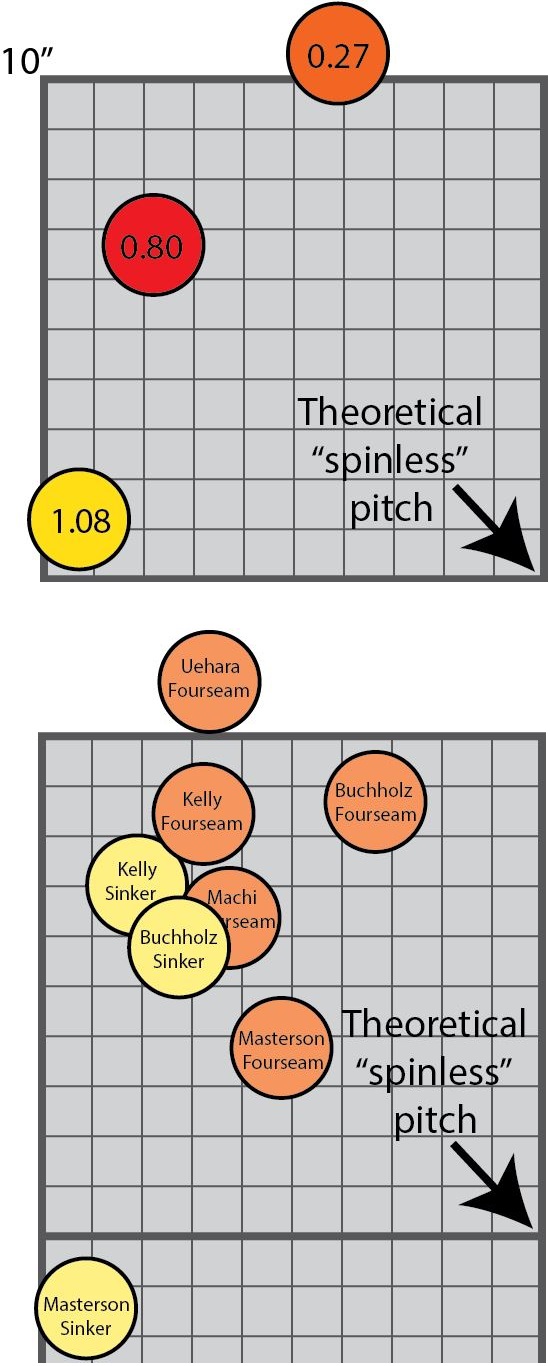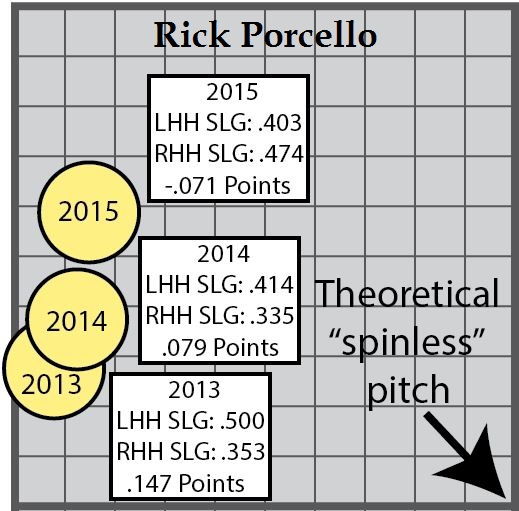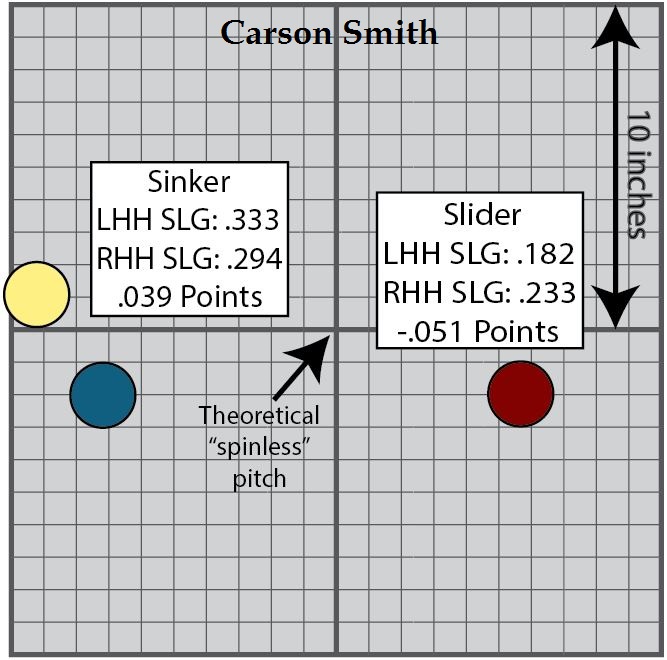Not all fastballs are alike. We think of cutters differently, but there’s a pretty wide spectrum of other fastballs — and in terms of movement, there isn’t always a lot to distinguish one pitcher’s fourseam from another’s sinker. We have PITCHf/x — we can do better. And there may be good reason to do so.
There’s a powerful trend: the more horizontal the movement, the greater the platoon split.
In April 2010, Max Marchi did a cluster analysis on the first three years’ worth of PITCHf/x data from right-handed pitchers and came up with 14 clusters, or categories. Not all right-handed pitchers’ offerings fall neatly into one of those categories, but there’s enough data in there that if one ran an analysis based on them, the results would be something to reckon with. Marchi returned to 12 of those categories a couple of weeks later and published some platoon splits. The results are pretty compelling
The short version is that there’s a powerful trend: the more horizontal the movement of a pitch, the greater the platoon split. Velocity also matters in an important way, with slower pitches less prone to positive platoon splits. I walked myself through the long version of this last week, which would give you more of an idea of what I’m getting at.
 Here, I want to talk specifically about fastballs, using the second of those general principles: the more horizontal the movement, the greater the platoon split. Here are the three fastball clusters/categories Marchi used that had average PITCHf/x velocities over 90 mph: the “Sinker” (yellow), the “Heater” (red), and the “Jumping Fastball” (orange). Movement presented from the catcher’s perspective.
Here, I want to talk specifically about fastballs, using the second of those general principles: the more horizontal the movement, the greater the platoon split. Here are the three fastball clusters/categories Marchi used that had average PITCHf/x velocities over 90 mph: the “Sinker” (yellow), the “Heater” (red), and the “Jumping Fastball” (orange). Movement presented from the catcher’s perspective.
The numbers inside are Marchi’s Run Value Per 100 Pitches calculations, giving you an idea of just how significant the differences are. Almost 1 run per 100 pitches is enough to make a “pretty good” pitch “pretty bad.” Still, these numbers don’t actually tell us that a “Sinker” fares much worse than a “Jumping Fastball” when a RHP faces a lefty hitter; they just tell us that when a RHP throws a “Sinker,” it does a lot worse against lefty hitters than it does against right-handed batters.
Pitchers with mainly horizontal offerings tend to have bigger platoon splits. A fastball/slider pitcher tends to have a hard time with that, but if most of the fastballs are true “sinkers” like the Marchi category? Let’s just say we all thought something like Justin Masterson’s .307/.409/.508 line against lefties in 2015 was within the realm of possibility before he ever put the uniform back on.
Not all of the sinkers thrown by Red Sox pitchers look even vaguely like the yellow “Sinker” category above. Naturally, not all have platoon splits so excruciatingly extreme. The only player here with laughably different platoon splits is Masterson; over the last two years, his fourseam was hit hard by hitters on both sides of the plate, but his sinker had a .288 batting average against with righties, while lefties tuned them up with a .345 average.
 One thing we may be able to do with all this: track changes in a single pitch’s movement, and see where that leads us. This last season, Rick Porcello’s sinker didn’t sink as much as it did in the previous two (his best two seasons).
One thing we may be able to do with all this: track changes in a single pitch’s movement, and see where that leads us. This last season, Rick Porcello’s sinker didn’t sink as much as it did in the previous two (his best two seasons).
The result? As Porcello’s sinker had more rise, lefties were limited more, but righties had a lot more fun. In 2015, Porcello’s sinker had about the same kind of “rise” as that of Clay Buchholz. It’s hard to see that kind of reverse platoon split continuing, but there is some support for the idea that it should be less positive if the pitch’s movement is at a more vertical angle.
 Joe Kelly has also seen his sinker get more rise as he’s pitched in the majors. The contrast is not as great as with Porcello, but once again: lefties generally had more success as the pitch’s movement was more vertical, and righties reaped the benefits. On that .449 SLG mark for lefties in 2015, note that in batting average, lefties dipped to just .279 on the pitch, after hitting over .300 in each of the previous three seasons.
Joe Kelly has also seen his sinker get more rise as he’s pitched in the majors. The contrast is not as great as with Porcello, but once again: lefties generally had more success as the pitch’s movement was more vertical, and righties reaped the benefits. On that .449 SLG mark for lefties in 2015, note that in batting average, lefties dipped to just .279 on the pitch, after hitting over .300 in each of the previous three seasons.
The Marchi numbers seem to work well as a cross-check for individual pitchers’ individual pitches and their platoon splits; when they don’t check out, maybe it’s worth raising an eyebrow. As an example: Carson Smith and his low arm angle have kind of tilted the movement of his pitches; a right-hander’s movement plot tends to lay out in something close to a 45 degree angle from top left to bottom right. Smith, though, has almost no rise at all on his sinker, and his change actually drops as compared to a spinless pitch (he threw the change just three times to righties last year; 60 to lefties). Meanwhile, if you were to put Smith’s slider into one of Marchi’s categories, the best one might be his “slurve” — the only pitch to have had a greater positive platoon split than Marchi’s true “sinker.” I’m not sure if it’s really a slurve — if you correct for Smith’s tilt, it starts to look more like a tight curve — but based on what we know, we might expect lefties to have more success against Smith than they did in 2015.
There’s not much to teach the Red Sox. I’ve been up and down the pitching staff, and, coincidence or not, they seem to have a pretty good feel for the platoon splits of individual pitches, and no pitcher seems to be crossed up in terms of defying the Marchi numbers. In terms of understanding what we’re seeing, though, I think this movement/platoon split business seems to have a ton of applications. Here’s to trying it out in more contexts in 2016.
Photo by Jennifer Nicholson/USA Today Sports Images

